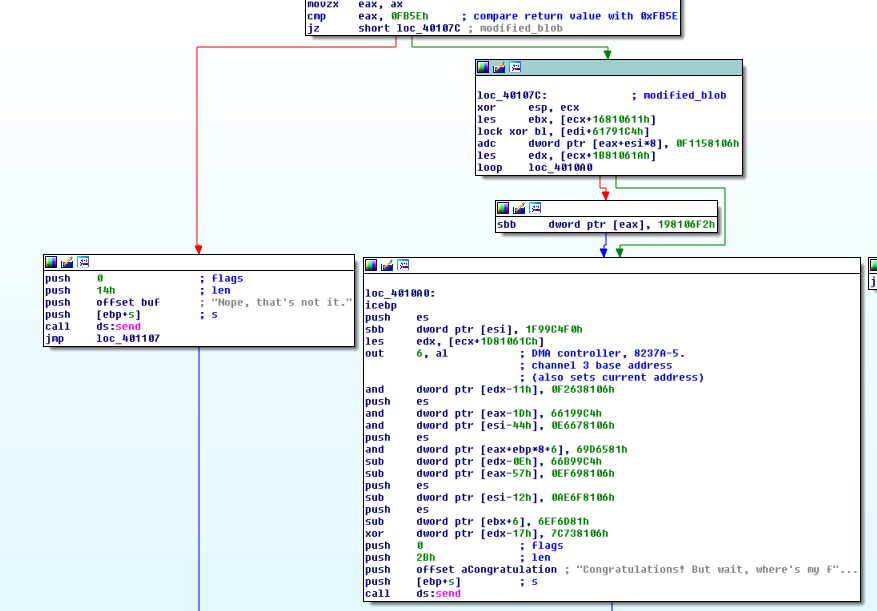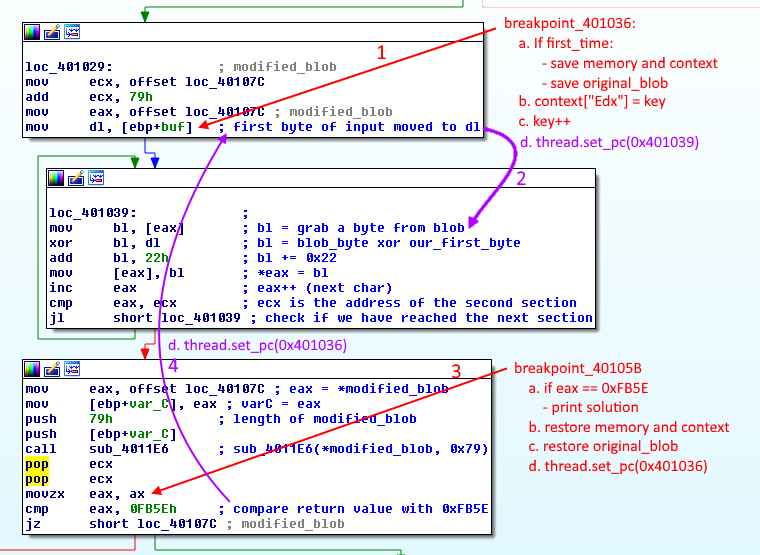Previous parts:
We have learned some good stuff. In this part I am going to talk about the original problem that led me to learning WinAppDbg. This is my writeup for challenge 3 "Greek to me" of FlareOn 2017. This is a bruteforce challenge and is rather easy but instead of bruteforcing it the conventional (and straightforward way), I will show how I traversed arbitrary Assembly blobs using WinAppDbg.
I will (hopefully) mostly talk about solving the challenge and not a lot of recon or other places I was stuck at.
Code is in my clone:
Setup
- Same Windows 7 32-bit VM from other parts.
- Get the binaries from this URL:
- http://flare-on.com/files/Flare-On4_Challenges.zip
- Password is
flare.
- Solutions:
Recon
Run strings on the binary. On Windows I have two favorites:
Running strings (from Sysinternals) we get:
-nobanner: do not display banner.-o: print the offset of the string (useful in case we want to use find the string in the file).
PS > .\SysinternalsSuite\strings.exe -o -nobanner .\3-GreektoMe\greek_to_me.exe
0077:!This program cannot be run in DOS mode.
0176:Rich
0432:.text
0472:.rdata
...
1584:Nope, that's not it.
1608:Congratulations! But wait, where's my flag?
1652:127.0.0.1
1752:WS2_32.dll
WS2_32.dll is the Windows socket library. So network connectivity.
Here's some interesting but unrelated info that I found when searching for the DLL:
127.0.0.1 means the application has network connectivity. It's either trying to connect to a port on localhost or listening on some port.
To discover, run procmon or Wireshark:
- Procmon filters:
process name is greek_to_me.exe.Operation is TCP/UDP Connect.
- Wireshark:
- Capture Windows loopback traffic with
npcap. - https://wiki.wireshark.org/CaptureSetup/Loopback
- Capture Windows loopback traffic with
Nothing. So it's listening on localhost.
Run the app and use netstat -anb in an Admin command prompt (needed for the b switch).
TCP 127.0.0.1:2222 0.0.0.0:0 LISTENING 5816
[greek_to_me.exe]
Application is listening on port 2222.
Short Analysis
The application is listening on port 2222. When it receives data, it uses the first byte (and only the first byte) of our input as we see here:
.text:00401029 loc_401029: ; CODE XREF: sub_401008+1A
.text:00401029 mov ecx, offset loc_40107C
.text:0040102E add ecx, 79h
.text:00401031 mov eax, offset loc_40107C
.text:00401036 mov dl, [ebp+buf] ; first byte of input moved to dl
Now dl points to the first byte that we sent to the socket.
.text:00401039 loc_401039: ; CODE XREF: sub_401008+3D
.text:00401039 mov bl, [eax] ; bl = grab a byte from blob
.text:0040103B xor bl, dl ; bl = blob_byte xor our_first_byte
.text:0040103D add bl, 22h ; bl += 0x22
.text:00401040 mov [eax], bl ; *eax = bl
.text:00401042 inc eax ; eax++ (next char)
.text:00401043 cmp eax, ecx ; ecx is the address of the second section
.text:00401045 jl short loc_401039 ; check if we have reached the next section
It grabs some data (0x79 or 121 bytes to be exact) from 0x40107C, XOR-es them with our first byte and then add 0x22.
The data is some blob at offset loc_40107C.
33 E1 C4 99 11 06 81 16 F0 32 9F C4 91 17 06 81
14 F0 06 81 15 F1 C4 91 1A 06 81 1B E2 06 81 18
F2 06 81 19 F1 06 81 1E F0 C4 99 1F C4 91 1C 06
81 1D E6 06 81 62 EF 06 81 63 F2 06 81 60 E3 C4
99 61 06 81 66 BC 06 81 67 E6 06 81 64 E8 06 81
65 9D 06 81 6A F2 C4 99 6B 06 81 68 A9 06 81 69
EF 06 81 6E EE 06 81 6F AE 06 81 6C E3 06 81 6D
EF 06 81 72 E9 06 81 73 7C
 XOR and ADD instructions
XOR and ADD instructionsThen this modified blob (after XOR and add) is passed to sub_4011E6 and processed:
.text:00401047 mov eax, offset loc_40107C ; eax = *modified_blob
.text:0040104C mov [ebp+var_C], eax ; varC = eax
.text:0040104F push 79h ; length of modified_blob
.text:00401051 push [ebp+var_C]
.text:00401054 call sub_4011E6 ; sub_4011E6(*modified_blob, 0x79)
.text:00401059 pop ecx
.text:0040105A pop ecx
.text:0040105B movzx eax, ax
.text:0040105E cmp eax, 0FB5Eh ; compare return value with 0xFB5E
.text:00401063 jz short loc_40107C
.text:00401065 push 0 ; flags
.text:00401067 push 14h ; len
.text:00401069 push offset buf ; "Nope, that's not it."
.text:0040106E push [ebp+s] ; s
.text:00401071 call ds:send
.text:00401077 jmp loc_401107
Return value of the sub_4011E6 is compared with 0xFB5E. If they do not match, jz will not be taken and execution will continue. Application will send back Nope, that's not it..
 Result comparison
Result comparisonNow here it gets interesting. If the results match, it will jump to the section which houses the blob we just modified and attempts to execute it as code. If the application does not crash and reaches the end, it will send back Congratulations!
In other words, our first byte is supposed to transform that blob into valid assembly opcodes.
Now we could solve this is in different ways. I think everyone solved it by opening a socket, sending 256 possible bytes and looking at the response. I think it's the way the challenge was meant to be solved.
Bruteforcing with WinAppDbg
I solved it a different way. Originally I went down the rabbit hole and tried to RE sub_4011E6. That was a shit-show. Then I realized I can use WinAppDbg to bruteforce the "crypto" in-memory. We need to learn a bit more about WinAppDbg to reproduce it.
Breakpoints in WinAppDbg
WinAppDbg allows us to set breakpoints at arbitrary addresses:
| |
When the breakpoint is hit, the action_callback function is called. We have not seen this before but all of our hooking has been performed internally with these instructions.
More info:
Getting and Setting Memory
WinAppDbg allows us to save/restore memory and context.
- Get memory:
memory = process.take_memory_snapshot() - Set memory:
process.restore_memory_snapshot(memory, bSkipMappedFiles=True)- restore_memory_snapshot source
- In general, keep the
bSkipMappedFilestoTrue. Otherwise you will get memory address violations.
Getting and Setting Context
Context contains register and flag values. It's per thread (instead of per process like memory).
- Get context:
context = thread.get_context()- get_context source
- Manipulate registers in context:
context["Edx"] = 0x1234
- Set context:
thread.set_context(context)
Note: After setting the context, we need to manually change the program counter to start execution at a specific location. For example if we grab the context, change Eip to an address and set it, the program counter will not change. After setting the context, manually change the program counter to your desired address with thread.set_pc(address).
For both memory and context operations, make sure to suspend the process/thread first and resume it after the operation is done.
Battle Plan
Now that we have the building blocks, we need to device a battle plan. It's very straightforward.
- Run the application.
- Set breakpoints at
0x401036and0x40105B. - Open a socket and send any random byte.
- At breakpoint
0x401036:- If it's first_time:
- Save memory, context and blob at
0x40107C.
- Save memory, context and blob at
context["Edx"] = key- swap the key.- key++.
- Bypass the key assignment instruction and manually jump to
0x401039with:thread.set_pc(0x401039)
- If it's first_time:
- At breakpoint
0x40105B:- If function return value is
0xFB5E, print key. - Else:
- Restore memory, context and blob at
0x40107C(blob has been modified so it needs to be restored to the original bytes). - Go back to
0x401036withthread.set_pc(0x401036)
- Restore memory, context and blob at
- If function return value is
 Bruteforcing plan
Bruteforcing planIt would have been easier to change the first byte of buf instead of edx and avoiding the jump labeled 2 in the picture.
Bruteforcing in Action
Code is in the repo and named 19-GreekToMe.py. You need to place greek_to_me.exe in the same directory. It's not in the repo so you need to download it from the website.
That was pretty fast because our address space was only one byte (0x00 to 0xFF).
$ python 19-GreekToMe.py
[21:23:48.0743] Starting simple_debugger
[21:23:48.0753] Started simple_debugger. Sleeping for 2 seconds.
[21:23:50.0756] Starting send_me.
[21:23:50.0875] Socket connected
[21:23:50.0875] Sent 0
[21:23:53.0490]
-------------------------------------------------------------------------------
Key: 0xa2
Eax: 0000FB5E
[21:23:54.0901] Reached 0x100
Flag
Run the application in a debugger, set a breakpoint at the "Congratulations!" instruction and send 0xA2. The blob results in the correct instructions and we get the flag.
flag: et_tu_brute_force@flare-on.com
Some More Analysis - Optional Read
This part is optional but I had already written them during the challenge.
Start of the app:
public start
start proc near
call sub_401008
xor eax, eax
retn
start endp
sub_401008 is called, then app returns 0 and exits.
Inside sub_401008 we see another subroutine sub_401121. Before that a *buf is pushed (as an argument) and is empty.
sub_401121
We can see the socket being constructed with WSAStartup:
lea eax, [ebp+WSAData]
push eax ; lpWSAData
push 202h ; wVersionRequested
call ds:WSAStartup
test eax, eax
jz short loc_401147
Then if WSAStartup was successful we can see the port and other parameters being passed to socket. IDA highlights a lot of them for us.
loc_401147:
push esi
push edi
push 6 ; protocol
push 1 ; type
push 2
pop edi
push edi ; af
call ds:socket
mov esi, eax
cmp esi, 0FFFFFFFFh
jz short loc_4011D8
We can see socket here. And of course the arguments are pushed to the stack from right to left.
- af = 2 = AF_INET = IPv4
- type = 1 = SOCK_STREAM = TCP socket
- protocol = 6 = IPPROTO_TCP = TCP
The string 127.0.0.1 is being converted to an inet address with inet_addr.
push offset cp ; "127.0.0.1"
mov [ebp+name.sa_family], di
call ds:inet_addr
Then port with htons.
push 8AEh ; hostshort
mov dword ptr [ebp+name.sa_data+2], eax
call ds:htons
"The htons function converts a u_short from host to TCP/IP network byte order (which is big-endian)."
Port number 0x8AE is 2222 decimal.
Then bind:
mov word ptr [ebp+name.sa_data], ax
lea eax, [ebp+name]
push 10h ; namelen
push eax ; name
push esi ; s
call ds:bind
"The bind function associates a local address with a socket."
After there is listen, accept and recv but we already know what they do.
Finally we are listening on 127.0.0.1:2222.
Let's take a closer look at recv.
"The recv function receives data from a connected socket or a bound connectionless socket."
push 0 ; flags
push 4 ; len
push [ebp+buf] ; buf
push edi ; s
call ds:recv
test eax, eax
jle short loc_4011CA
Buf from the parameter is going to be the pointer to the data received. recv returns the number of bytes received (which going to be in eax).
If nothing was received, the jle is successful and socket is closed.
Otherwise the function returns the number of received bytes.
The rest is explained above.
Conclusion
I think I am going to stop writing back-to-back blogs for a few days. I have had 0 off-time. But I am glad I learned WinAppDbg, it will help me a lot in my day job.
As usual if you have any suggestions or catch any errors, feel free to contact me.